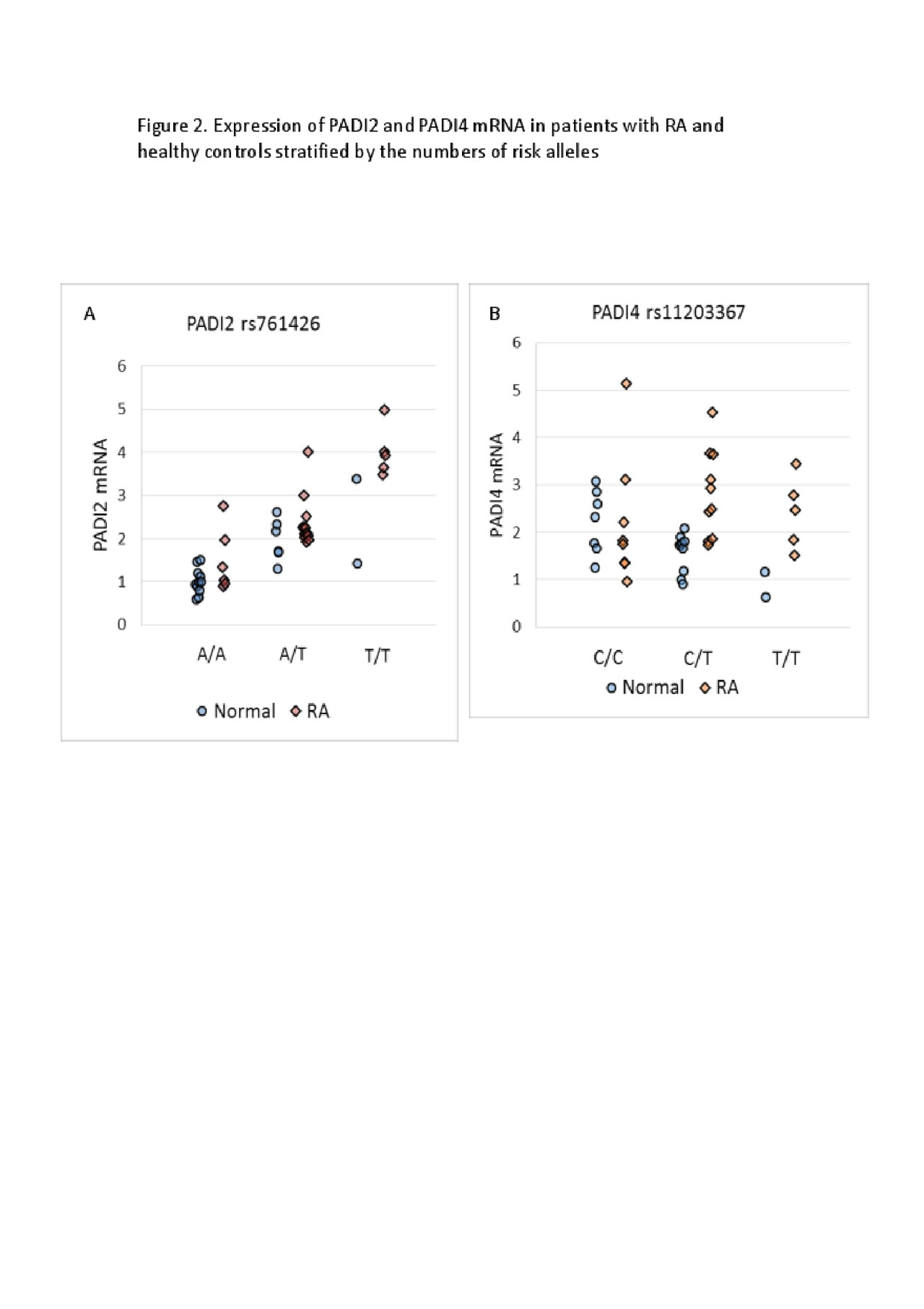Session Information
Session Type: Poster Session (Tuesday)
Session Time: 9:00AM-11:00AM
Background/Purpose: Peptidyl-arginine deiminases (PADIs) are enriched in neutrophils and considered to be responsible for citrullination of proteins in vivo. Autoantibody against citrullinated proteins are frequently detected in patients with rheumatoid arthritis (RA) and are highly diagnostic for the disease. PADI activity is detected in synovial fluid, and citrullinated proteins are found in synovium of patients with RA. Genetic evidence has shown that single nucleotide variants (SNVs) of PADI2 and PADI4 genes are associated with RA susceptibility. We aimed to elucidate association of SNVs of PADIs and their expression in peripheral blood neutrophils from patients with RA.
Methods: We enrolled 23 patients who fulfilled the 2010 American College of Rheumatology / European League Against Rheumatism classification criteria for RA and 20 healthy controls. Peripheral blood neutrophils were separated by using magnetic beads and applied to in vitro culture and extraction of genomic DNA. Neutrophils were cultured with or without stimulation for 48 hours and supernatants were collected to measure PADI2 and PADI4 by using enzyme-linked immunosorbent assay. SNVs of PADI2 and PADI4 were determined by using TaqMan SNP Genotyping Assays. Quantitative real-time RT-PCR was used to measure mRNA levels of PADI2 and PADI4.
Results: Fresh neutrophils from patients with RA expressed significantly larger amounts of PADI2 (p = 0.001) and PADI4 (P = 0.003) mRNA, than healthy controls (Figure 1). Neutrophils spontaneously released PADI2 and PADI4. Upon stimulation with PMA (20 and 200 microM), secretion of PADI2 significantly increased in patients with RA (p = 0.003 for 20 microM; p = 0.001 for 200 microM), but not in healthy controls. On the contrary, secretion of PADI4 significantly decreased in healthy controls at both PMA concentrations (p = 0.001 for 20 microM; p = 0.003 for 200 microM), but only at 20 microM in patients with RA (p = 0.05 for 20 microM, p = 0.5 at 200 microM). Patients and healthy controls were stratified by numbers of risk allele in SNVs of PADI genes, and mRNA levels of PADIs were compared (Figure 2). Multiple linear regression analyses revealed that RA (versus healthy controls) [nonstandardized partial regression coefficient (NPRC) = 1.29, 95% confidence interval (95% CI) 0.67 – 1.91, p = 0.001] and numbers of the risk allele of PADI2 rs761426 (A – >T) (NPRC = 0.20, 95% CI = 0.010 – 0.39, p = 0.04) were significantly associated with the levels of PADI2 mRNA in neutrophils. RA (versus healthy controls) was also associated with the levels of PADI4 mRNA in neutrophils (NPRC = 0.95, 95% CI = 0.36 – 1.55, p = 0.002), but not numbers of the risk allele of PADI4 rs11203367 (C – >T).
Conclusion: Expression levels of PADI2 and PADI4 mRNA were higher in patients with RA compared to healthy controls, but their association with SNVs are different. Secretion of these PADIs upon stimulation with PMA were different, which may suggest their independent physiological and pathological roles in vivo.
To cite this abstract in AMA style:
Harigai M, Sakai R, Sugihara T, Ishigami A. Expression of Peptidyl-arginine Deiminases in Peripheral Blood Neutrophils and Its Association with Single Nucleotide Variants in Patients with Rheumatoid Arthritis [abstract]. Arthritis Rheumatol. 2019; 71 (suppl 10). https://acrabstracts.org/abstract/expression-of-peptidyl-arginine-deiminases-in-peripheral-blood-neutrophils-and-its-association-with-single-nucleotide-variants-in-patients-with-rheumatoid-arthritis/. Accessed .« Back to 2019 ACR/ARP Annual Meeting
ACR Meeting Abstracts - https://acrabstracts.org/abstract/expression-of-peptidyl-arginine-deiminases-in-peripheral-blood-neutrophils-and-its-association-with-single-nucleotide-variants-in-patients-with-rheumatoid-arthritis/


